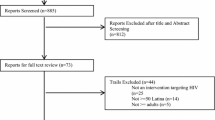Abstract
Worldwide, military personnel have been recognized as a population at elevated risk for sexually transmitted infections and HIV. However, few evidence based behavioral interventions for the prevention of HIV and STIs have been rigorously evaluated in military personnel. We adapted the Popular Opinion Leaders (POL) intervention and piloted the adapted program with the Barbados Defence Force at one military base in Barbados. Popular Opinion Leaders were selected and trained to focus conversations on condom use. Behavioral questionnaires were administered using audio computer-assisted self interview at baseline (n = 256) and 6-month follow-up (n = 303). Mid-point focus groups were conducted with a sample of 15 POLs at a 3 month mid-point assessment. Quantitative data showed moderate increases in condom use at 6-months, and significant uptake of condom use during oral-genital contact in female personnel. A subgroup analysis suggests that this change was partially mediated by post-intervention changes in injunctive norms surrounding condom use in women. Focus groups revealed that POLs were heavily focusing on condom demonstrations, condom provision within social networks, speaking with coworkers about pleasure associated with condom use, and that the most common venues for conversations included those where alcohol was consumed. During the intervention, POLs dispersed from the intervention site as a result of normal personnel movement across bases, resulting in our having to use a pre and post intervention design across the population. It is likely that larger effect sizes would be observed in efforts that account for the natural dispersion of personnel across bases.
Similar content being viewed by others

References
Anastario, M., et al. (2011). HIV infection, sexual risk behaviour and condom use in the Belize defense force. International Journal of STD AIDS, 22(2), 73–79.
Okulate, G., Jones, O., & Olorunda, M. (2008). Condom use and other HIV risk issues among Nigerian soldiers: Challenges for identifying peer educators. AIDS Care, 20(8), 911–916.
Brodine, S. K., et al. (2003). Diverse HIV-1 subtypes and clinical, laboratory and behavioral factors in a recently infected US military cohort. Aids, 17(17), 2521–2527.
de Waal, A., Klot, J., & Mahajan, M. (2009). HIV/AIDS, security and conflict: New realities, new responses. Social Science Research Council.
Kelly, J. A. (2004). Popular opinion leaders and HIV prevention peer education: Resolving discrepant findings, and implications for the development of effective community programmes. AIDS Care, 16(2), 139–150.
Kelly, J. A., et al. (1997). Randomised, controlled, community-level HIV-prevention intervention for sexual-risk behaviour among homosexual men in US cities. Community HIV Prevention Research Collaborative. Lancet, 350(9090), 1500–1505.
Kelly, J. A., et al. (2006). Prevention of HIV and sexually transmitted diseases in high risk social networks of young Roma (Gypsy) men in Bulgaria: Randomised controlled trial. BMJ, 333(7578), 1098.
Anastario, M. P., Tavarez, M. I., & Chun, H. (2010). Sexual risk behavior among military personnel stationed at border-crossing zones in the Dominican Republic. Rev Panam Salud Publica, 28(5), 361–367.
Siebold, G. L. (2007). The essence of military group cohesion. Armed Forces and Society, 33(2), 286–295.
Ghanem, K. G., et al. (2005). Audio computer assisted self interview and face to face interview modes in assessing response bias among STD clinic patients. Sexually Transmitted Infections, 81(5), 421–425.
Risk Behavior Assessment Questionnaire. Rockville, MD, National Institute on Drug Abuse: Community Research Branch, pp. 16–44 (1993, October).
Cherpitel, C. J. (2002). Screening for alcohol problems in the U.S. general population: Comparison of the CAGE, RAPS4, and RAPS4-QF by gender, ethnicity, and service utilization. Rapid alcohol problems screen. Alcoholism, Clinical and Experimental Research, 26(11), 1686–1691.
Stata 10. College Station, Texas: Stata Corporation (2007).
Charmaz, K. (2006). Constructing grounded theory: A practical guide through qualitative analysis. Thousand Oaks: Sage.
Charmaz, K. (2000). Grounded theory: Objectivist, constructivist methods. Thousand Oaks: Sage.
Rotheram-Borus, M. J., et al. (2011). Reductions in sexually transmitted infections associated with popular opinion leaders in China in a randomised controlled trial. Sexually Transmitted Infections, 87(4), 337–343.
Schneider, J. A., & Laumann, E. O. (2011). Alternative explanations for negative findings in the community popular opinion leader multisite trial and recommendations for improvements of health interventions through social network analysis. Journal of Acquired Immune Deficiency Syndrome, 56(4), e119–e120.
Chun, H., et al. (2011). Interviewer gender and self-reported sexual behavior and mental health among male military personnel. International Journal of Public Health, 56(2), 225–229.
Acknowledgments
This work was supported by the United States Department of Defense HIV/AIDS Prevention Program under Work Unit # 60150. The views expressed in this article are those of the authors and do not reflect the official policy or position of the Department of the Navy, Department of Defense, or the U.S. Government. Approved for public release; distribution is unlimited. This research has been conducted in compliance with all applicable federal regulations governing the protection of human subjects in research (Grant N00244-10-1-0030).
Author information
Authors and Affiliations
Corresponding authors
Rights and permissions
About this article
Cite this article
Anastario, M.P., Dabreo, J., Morris, J. et al. Condom Use Following a Pilot Test of the Popular Opinion Leader Intervention in the Barbados Defence Force. J Community Health 38, 46–53 (2013). https://doi.org/10.1007/s10900-012-9577-5
Published:
Issue Date:
DOI: https://doi.org/10.1007/s10900-012-9577-5



